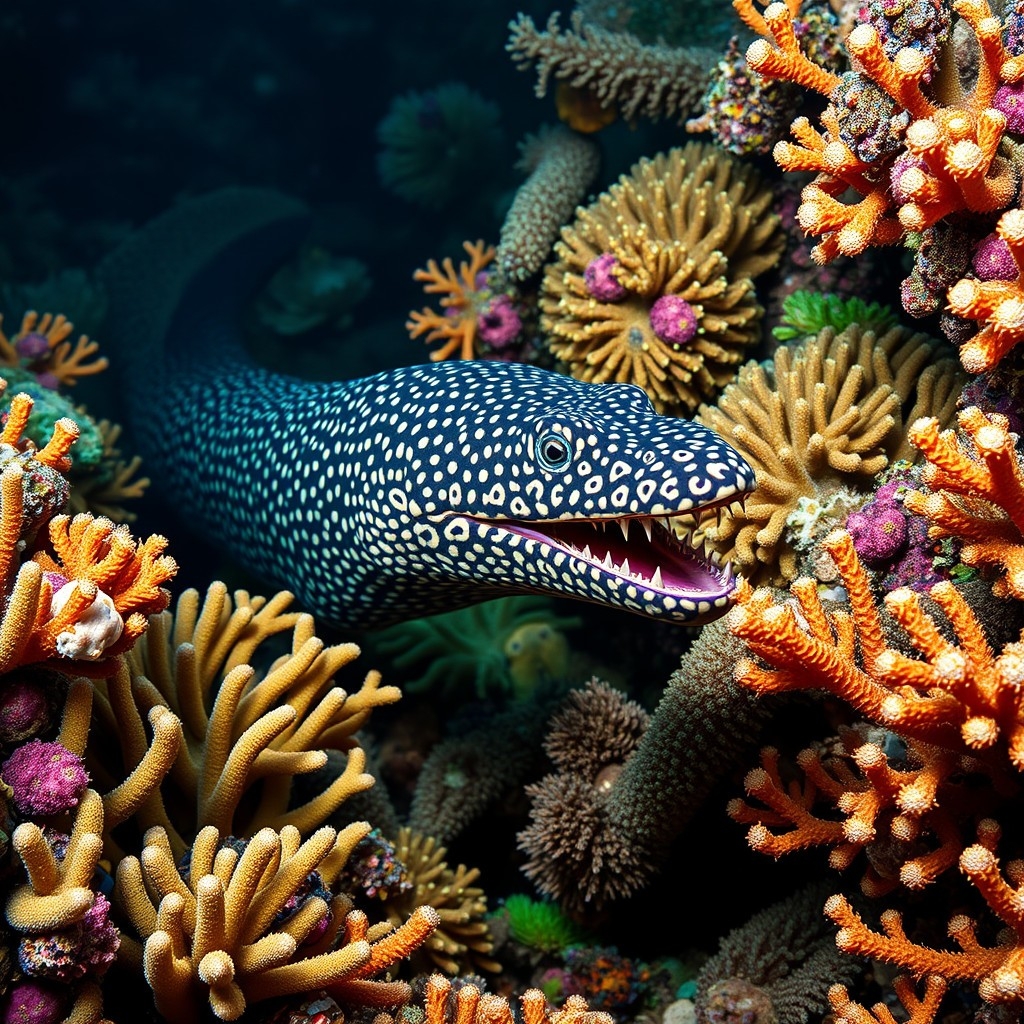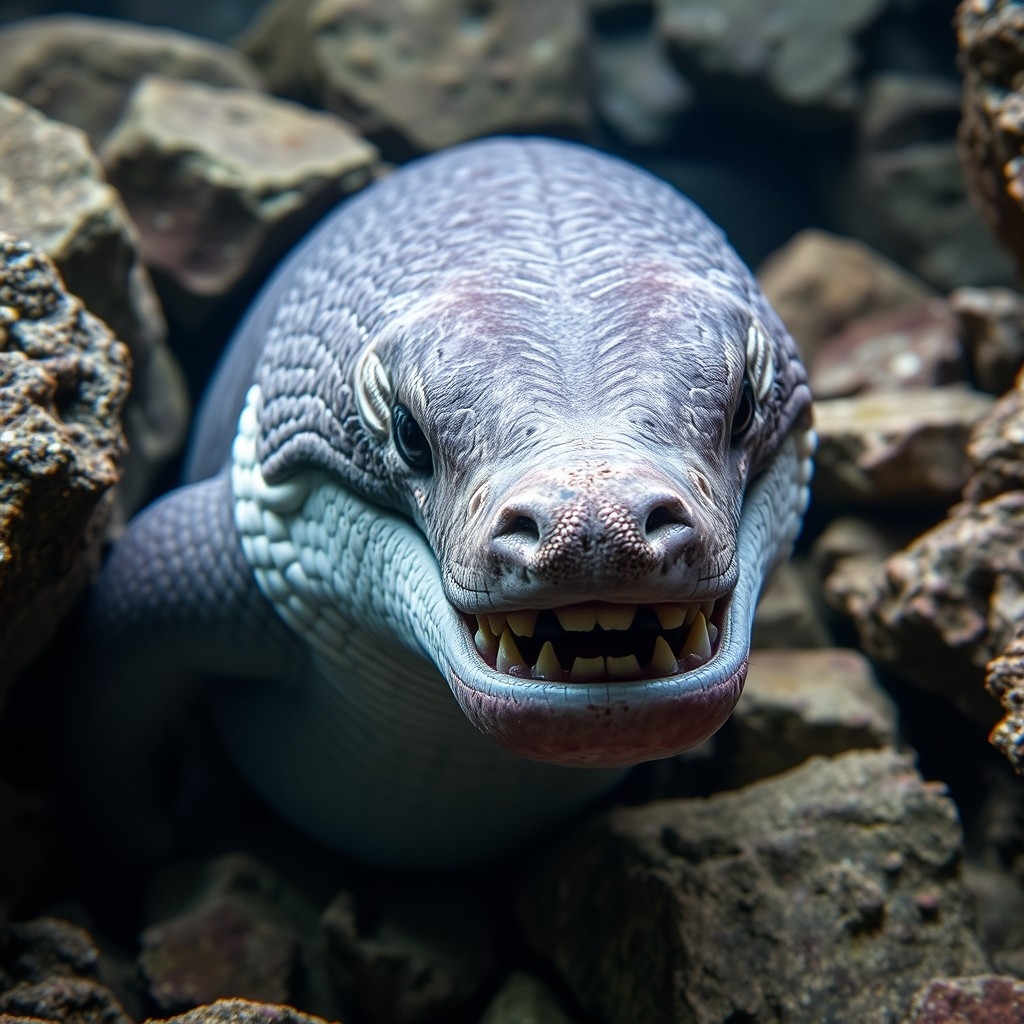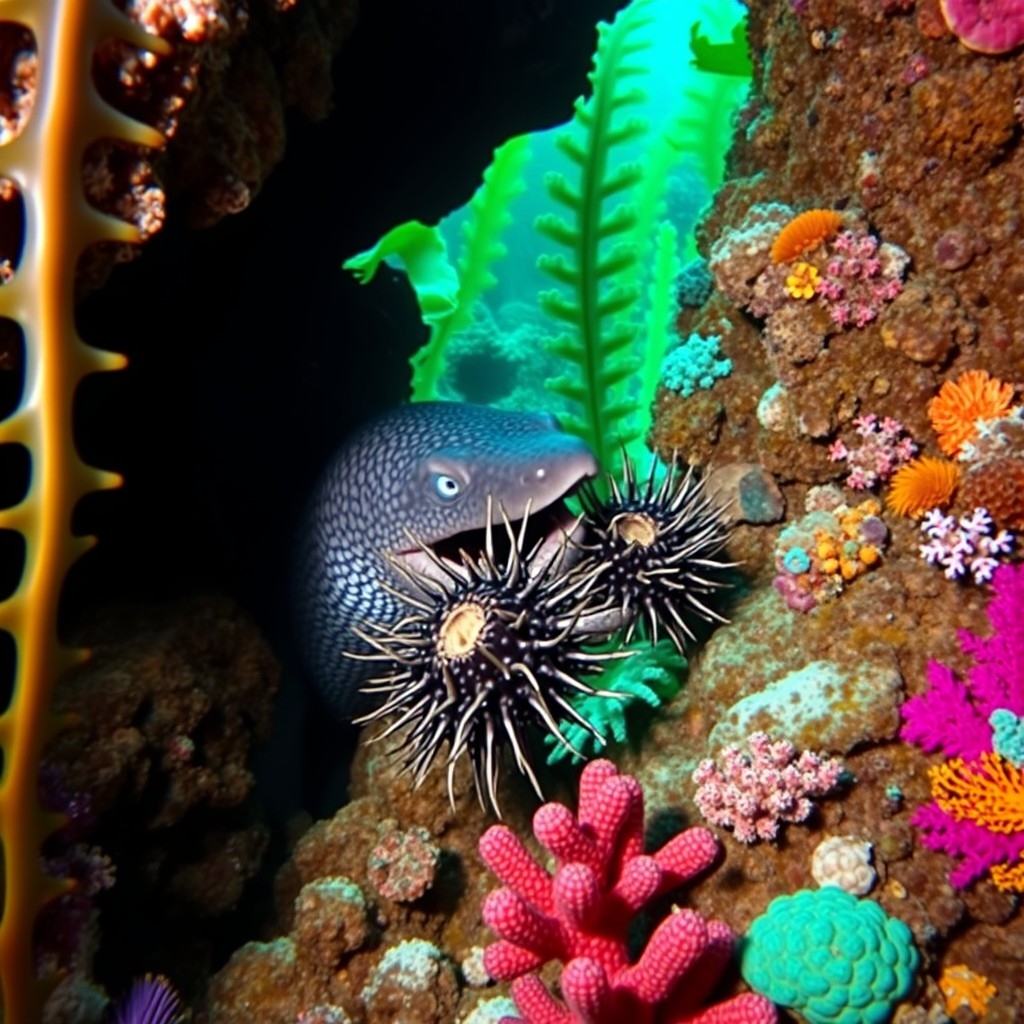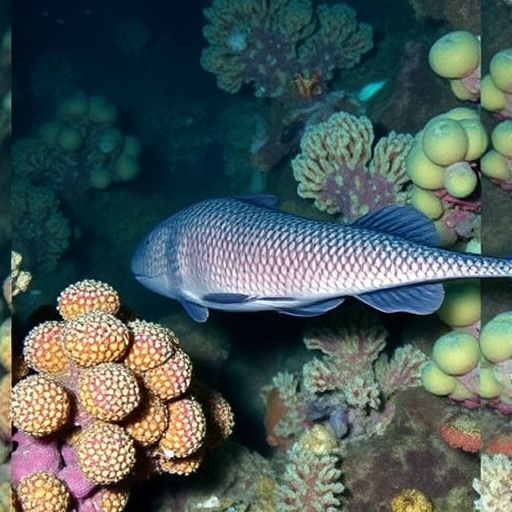Wolf Eel — The Pacific's Unusual Fish
Discover the intriguing life of the wolf eel, the Pacific Ocean's unique and gentle fish.
Have you ever heard of the wolf eel? This amazing fish might surprise you! Despite its fierce name and looks, the wolf eel is a gentle giant in the Pacific Ocean. It's not actually an eel but a long, slender fish with a unique personality. With strong jaws and a friendly nature, the wolf eel fascinates divers and marine enthusiasts alike. Let's dive in and discover what makes the wolf eel such a special creature under the waves.

Not Really an Eel
The wolf eel (Anarrhichthys ocellatus) gets its name from its long, eel-like body and wolf-like face. But here's something cool: it's not an eel at all! It's part of the wolffish family. These fish live only in the North Pacific Ocean and are known for their distinct looks and behaviors.
The scientific name comes from Greek and Latin words. "Anarrhichthys" means "climbing fish," and "ocellatus" refers to the eye-like spots on its body. These spots are bright on young wolf eels but fade as they grow up.
A Fish with Personality
Wolf eels have their own unique personalities. Some divers say they're curious and even playful. They often peek out from their homes to watch people swimming by, and some have even taken food from human hands. This curiosity makes them stand out from many other sea creatures.
The Wolf Eel's Unique Look
One glance at a wolf eel, and you'll see why it gets attention. With a broad, grumpy-looking face and powerful jaws filled with sharp teeth, it might seem scary. Their teeth are perfect for crushing the hard shells of their favorite foods.
Adult wolf eels have thick, grayish skin that helps them blend into rocky surroundings. They can grow up to eight feet long and weigh up to 40 pounds! Young wolf eels are bright orange or reddish-brown with dark spots and patterns. These colors help them hide among seaweeds and corals.
Built for Life Underwater
Their long, snake-like bodies are flexible, letting them slip into narrow cracks in rocky reefs. Unlike true eels, wolf eels have pectoral fins just behind their heads, which help them move around in tight spaces. You can tell them apart from true eels by these fins.
Their skin is covered with a thick layer of mucus, acting like a protective coat against parasites and infections. This slippery layer also helps them squeeze into the tightest spots where they like to hide.

Home Sweet Home: Where Wolf Eels Live
Wolf eels are creatures of habit in the North Pacific Ocean. They're found along the coast from the Sea of Japan and the Aleutian Islands in Alaska down to southern California. They love the cooler northern waters and usually live between 30 to 740 feet deep.
They prefer rocky areas with lots of crevices, caves, and hideouts. These places offer shelter from predators and great spots to catch prey. Each wolf eel picks a den, which it may call home for years. Sometimes, a mating pair will share a den, turning it into a cozy underwater dwelling.
Staying Close to Home
Wolf eels are loyal to their homes. Even when danger is near, they might retreat deeper into their dens instead of swimming away. This attachment to their den makes them an important part of their local underwater neighborhood.
Their homes are often in places rich with life, like kelp forests and reef systems. These environments support many different species, making the wolf eel an important neighbor in these underwater communities.
What's on the Menu? Wolf Eel Diet
When it's time to eat, wolf eels know what they like. They mainly munch on hard-shelled animals. Crabs, sea urchins, mussels, clams, and even snails are all favorites. Their strong jaws and special molar-like teeth are perfect for crushing tough shells.
By eating sea urchins, wolf eels help keep kelp forests healthy. If sea urchin numbers get too high, they can destroy kelp beds. By keeping urchins in check, wolf eels help protect these important underwater ecosystems.
Lovers of Crunchy Foods
Sometimes, they'll also eat slow-moving or bottom-dwelling fish. They hunt by patiently waiting in their dens or slowly creeping along the ocean floor, using their keen sense of smell to find food.
Their diet makes them important predators in their environment. By controlling the numbers of certain creatures, they help keep the ecosystem balanced.

Life and Behavior of the Wolf Eel
Wolf eels aren't just interesting to look at—they have fascinating behaviors too. One of the most remarkable things is their tendency to form lifelong pairs. Unlike many fish, wolf eels often mate for life. A pair will share a den and work together in many parts of their lives.
During breeding season, the female lays a mass of eggs—sometimes up to 10,000! Both parents take turns wrapping their bodies around the eggs to protect them and keep them healthy. This teamwork in parenting is pretty rare among fish and shows their strong bond.
Teamwork Makes the Dream Work
The eggs take about 13 to 16 weeks to hatch. During this time, the parents are watchful guardians, fanning the eggs with their fins to keep them clean and full of oxygen. They are attentive and protective, showing a level of care that's unusual among fish.
When the eggs hatch, the tiny larvae drift into the open ocean currents. The young wolf eels will eventually settle on the ocean floor, find their own dens, and start the cycle all over again.
Growing Up: The Wolf Eel's Life Cycle
Wolf eels have an amazing life journey. As youngsters, they look very different from the adults. Their bright colors and patterns help them hide among seaweed and coral.
They become adults around the age of seven. Once they find a mate, they might stay together for the rest of their lives. Wolf eels can live up to 25 years or more in the wild, although it's hard to know their exact age.
Changes Over Time
The change from bright young wolf eel to the more muted adult is gradual. As they grow, they start moving to deeper waters and look for more permanent homes. Their habitat shift matches changes in their diet and behavior.
How Wolf Eels Survive
Wolf eels have several features that help them survive in the tough environments of the Pacific Ocean.
Strong Jaws and Teeth
Their jaws are super strong, with sharp teeth at the front and molar-like teeth in the back. This setup lets them grab and crush their prey easily. Eating hard-shelled animals wouldn't be possible without these special teeth.

Flexible Bodies
Their long, flexible bodies are perfect for moving around the complex terrain of rocky reefs. They can twist and turn to squeeze into tight spaces where they find shelter and hunt.
Sharp Senses
Wolf eels rely on their sense of smell to find food. Since they often hunt in dark places where it's hard to see, being able to detect smells is key.
Living with Others Underwater
Wolf eels share their homes with many other sea animals. They interact with both predators and prey in their world.
Predators and Threats
While adult wolf eels don't have many natural predators because of their size and hidden lifestyle, young ones are more at risk. Bigger fish, sharks, and seals might prey on young wolf eels.
Neighbors in the Reef
Sometimes, small fish and other creatures share the wolf eel's den, enjoying the shelter and any leftover food. Living together like this adds to the complexity of their underwater community.
Wolf Eels and People
Despite their scary appearance, wolf eels are usually not aggressive toward people. It's rare for them to bite divers, and it usually only happens if the eel feels threatened or provoked. Their strong jaws can cause injury, so it's best to respect their space.
Many divers and underwater photographers love to find wolf eels because of their photogenic looks and interesting behaviors. Since they tend to stay in one place, they're relatively easy to find once you know where to look.
A Favorite Among Divers
Some wolf eels have become local stars at popular dive spots. They might recognize regular visitors and show curiosity when approached. This friendly interaction has made them favorites in the diving community.
In Aquariums
Wolf eels are sometimes kept in public aquariums, where they help teach people about marine life. Visitors can watch them up close, learning to appreciate these unique fish.
Wolf Eels in Stories and Traditions
While not as famous as some sea creatures, wolf eels do appear in the traditions of certain coastal communities.
Cultural Importance
In some Indigenous cultures of the Pacific Northwest, sea life is an important part of stories and art. The wolf eel, with its distinct look, might feature in local legends or as a symbol in totem poles and carvings.

Keeping Wolf Eels Safe
Wolf eels aren't currently listed as endangered or threatened. However, like many sea creatures, they face challenges from human activities. Overfishing, accidental catching, habitat damage, and pollution can harm their populations.
Effects of Fishing
Although they're not a main target for commercial fishing, wolf eels can be caught by accident in traps and nets meant for other species. This accidental catching can reduce their numbers if not properly managed.
The Need to Protect Their Homes
Protecting their habitats is crucial. The rocky reefs and kelp forests where they live are sensitive environments. Efforts to keep the oceans healthy benefit wolf eels and many other species.
Marine protected areas and responsible fishing rules help ensure that wolf eel populations stay healthy. Research and monitoring are important to understand how they're doing.
How You Can Make a Difference
You can help by supporting sustainable fishing practices and reducing pollution. Simple actions like properly disposing of trash, using fewer plastics, and supporting marine conservation groups can make a big impact.
Spread the Word
Teaching others about the wolf eel and its role in the ocean helps build a culture of respect for marine life. By valuing these unique creatures, we contribute to preserving the incredible diversity under the sea.
Why Wolf Eels Matter
Wolf eels are more than just interesting fish; they play an important role in their environment.
Keeping the Ecosystem Balanced
By eating sea urchins and other creatures, wolf eels help keep the marine ecosystem in balance. This prevents overgrazing of kelp forests, which are important habitats for many species.
Signs of a Healthy Ocean
Healthy populations of wolf eels can indicate a thriving marine ecosystem. Their presence suggests that the environment supports a complex web of life, from tiny plankton to larger predators.
Celebrating the Wolf Eel
The wolf eel is a remarkable and often misunderstood fish that adds richness to our oceans. From its unique looks and lifelong partnerships to its role in keeping marine ecosystems healthy, the wolf eel offers much to admire. Whether you're a diver meeting a curious face in a rocky crevice or someone fascinated by marine life, the wolf eel invites us to look closer and appreciate the wonders of nature. Let's continue to protect and celebrate this gentle giant of the Pacific Ocean so future generations can enjoy its presence in our shared world.
FAQ
What kind of animal is a wolf eel?
A wolf eel is a type of fish found in the North Pacific Ocean. Despite its name, it's not actually an eel but belongs to the wolffish family.
Are wolf eels dangerous to humans?
Generally, wolf eels are not aggressive toward humans. They might bite if they feel threatened, but they're usually shy and can even be friendly with divers.
How big do wolf eels get?
Wolf eels can grow up to eight feet long and weigh as much as 40 pounds. Males tend to be larger than females.
What do wolf eels eat?
They eat hard-shelled creatures like crabs, clams, sea urchins, and mussels. Their powerful jaws allow them to crush shells easily.
Do wolf eels mate for life?
Yes, wolf eels are known to form lifelong pairs. They share a den and work together to protect their eggs.
Where do wolf eels live?
They live in the rocky areas of the North Pacific Ocean, from shallow coastal waters down to depths of around 740 feet. They like crevices and caves where they can hide.
How long do wolf eels live?
Wolf eels can live up to 25 years or more in the wild. Their long lifespan is part of what makes their lifelong pairing so special.
What helps wolf eels survive?
Their powerful jaws and special teeth let them crush hard shells. Their long, flexible bodies help them move through tight spaces in rocky reefs.

I'm a scuba enthusiast, and marine life lover. I enjoy writing about my diving adventures and sharing my knowledge with others.

I'm a passionate scuba diver and love to share my experiences with you. I enjoy writing about my experiences and sharing my knowledge with others.